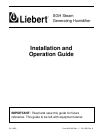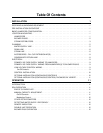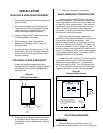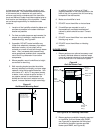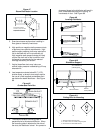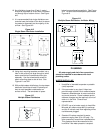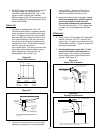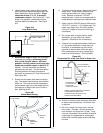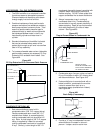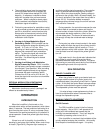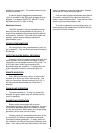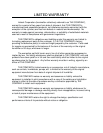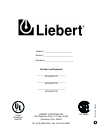
information is relevant to all controls, factory supplied
or otherwise.
A, B and C (described below) are to be wired in
series (only one path for current) across terminals 8
and 10 on the low voltage control terminal strip, or
replaced with a jumper wire for constant operation
(see Figure #27). Caution: If any control field wiring
touches ground metal unit, safeties will be bypassed.
A - Wall or Duct Mounted Control On/Off
Humidistat: Wired to make on drop in humidity, break
on rise to setpoint. Set to desired % RH. Can be a
make/break set of contacts from a Building Automation
System.
B - Duct Mounted Safety High Limit On/Off
Humidistat (if used): Wired to make on drop in
humidity, break on rise to safety setpoint. Set to
approximately 85% RH as a safety to help prevent
saturation and wetting in the duct.
C - Duct Mounted Safety Air-Proving On/Off
Switch (if used): Wired to make when sensing air
flow, break when no air flow. Used as a safety to
prevent saturation when no air flow.
1. Liebert offers various versions of A, B and C to
suit each application. In general, A is
essential, whereas B and C are highly
recommended in ducted applications.
2. Field wiring from humidistat to humidifier and
between devices should be 18 AWG or
heavier and kept as short as possible.
3. Low voltage control terminal strips are
provided in the electrical compartment.
Internal sides are factory wired. External
sides are to be field wired.
4. Each humidifier is supplied with a wiring
diagram inside.
CONTROL INSTALLATION
1. Mount any wall humidistat (control or high
limit) over standard electrical box at height
similar to typical thermostat. Any wall
humidistat should be in location
representative of overall space being
humidified and not in path of blower pack or
air supply grille. Do not mount on a outside
wall where temperature fluctuation can affect
control response.
2. Mount duct humidistat in location
representative of overall air humidity, usually
return duct. Do not mount it directly in front of
steam distributor or in turbulent or mixing zone
or down stream from distributor. Mount it
where air’s humidity and temperature are
uniform and representative of spaces being
humidified.
3. Mount duct high limit humidistat
downstream of steam distributors far enough
that, under normal humidity and air flow
conditions, steam will have been fully
absorbed (typically at least 10 feet). It must
be located to sense high humidity only when
uniform and representative air is
over-humidified or approaching saturation.
4. Mount duct air-proving switch so that it is
able to sense air flow or lack of it. Wire it to
make when air flow is sensed and break when
air flow fails. Mount prior to distributor.
5. Check operation of all on/off controls before
starting humidifier.
6. Calibration of controls (on/off or modulation) in
the field may be necessary due to shipping
and handling. Verify humidistat accuracy
before commissioning system.
OPTIONAL MODULATION (CONTINUOUS
CONTROLS) (see Figure #28)
1. Read on/off controls section first since it is
necessary to all control systems.
2. Virtually any modulation (continuous control)
external hardware by others (as long as it has
%RH setpoint circuitry) may be interfaced with
pre-specified factory-configured SGH pc
board via the control terminal strip.
3. Modulation (continuous control) by others for
use with SGH humidifiers involves one of
several control wiring diagrams. In all cases,
modulating signal interfaces through control
terminal strip to main pc board inside
humidifier.
-10-
A
B
C
810 32 30
V
ar
i
es
Wi
t
hE
ac
h
ModulationOption
SeeLiebertSupplied
ExternalWiringDiagram
External
Internal
y
_
Figure #26
Typical Modulation Wiring



